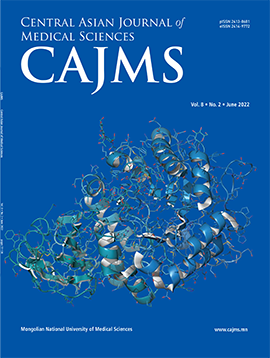Prevalence of Blue Spot among Mongolian Newborn Infants
DOI:
https://doi.org/10.24079/cajms.2017.11.007Keywords:
Birthmark, Mongolian Spot, InfantsAbstract
Objectives: The aim of this study was to determine the prevalence and characteristics of Mongolian spots in Mongolian infants. Methods: This hospital-based, descriptive cross-sectional study was conducted nationwide among 2641 newborn infants in Ulaanbaatar and in 21 provinces hospitals within 96 hours postpartum in 2015. Results: The prevalence of Mongolian spots in Mongolian infants was 91.3%. The prevalence of spots in females was 92.1% and in male newborns it was 90.6% (p>0.05). The prevalence of Mongolian spots in the Western provinces was lower than in the rest of other provinces (98.3% and 95% CI: 96.4-99.4). For of infants with Khalkha parentage, 92.7% had Mongolian spots, while 64.7% of infants with Kazakh parentage had Mongolian spots. The Mongolian spots are commonly located in infant’s lower back (88.3%) and had an average length of 3.7±2.7 cm, width of 2.7±1.9 cm and an average area of 14.2±23.3 cm2. The appearance of Mongolian spots on the infant’s legs, face, chest, hands, feet, knee, and cheeks were less frequent. Conclusion: The prevalence of Mongolian spots among Mongolian infants was 91.3% [95%CI: 87.2-95.3] and significant difference was observed between Mongolian and Kazakh infants.
Downloads
273
Downloads
Published
How to Cite
Issue
Section
License
Copyright (c) 2017 Mongolian National University of Medical Sciences

This work is licensed under a Creative Commons Attribution-NonCommercial 4.0 International License.




